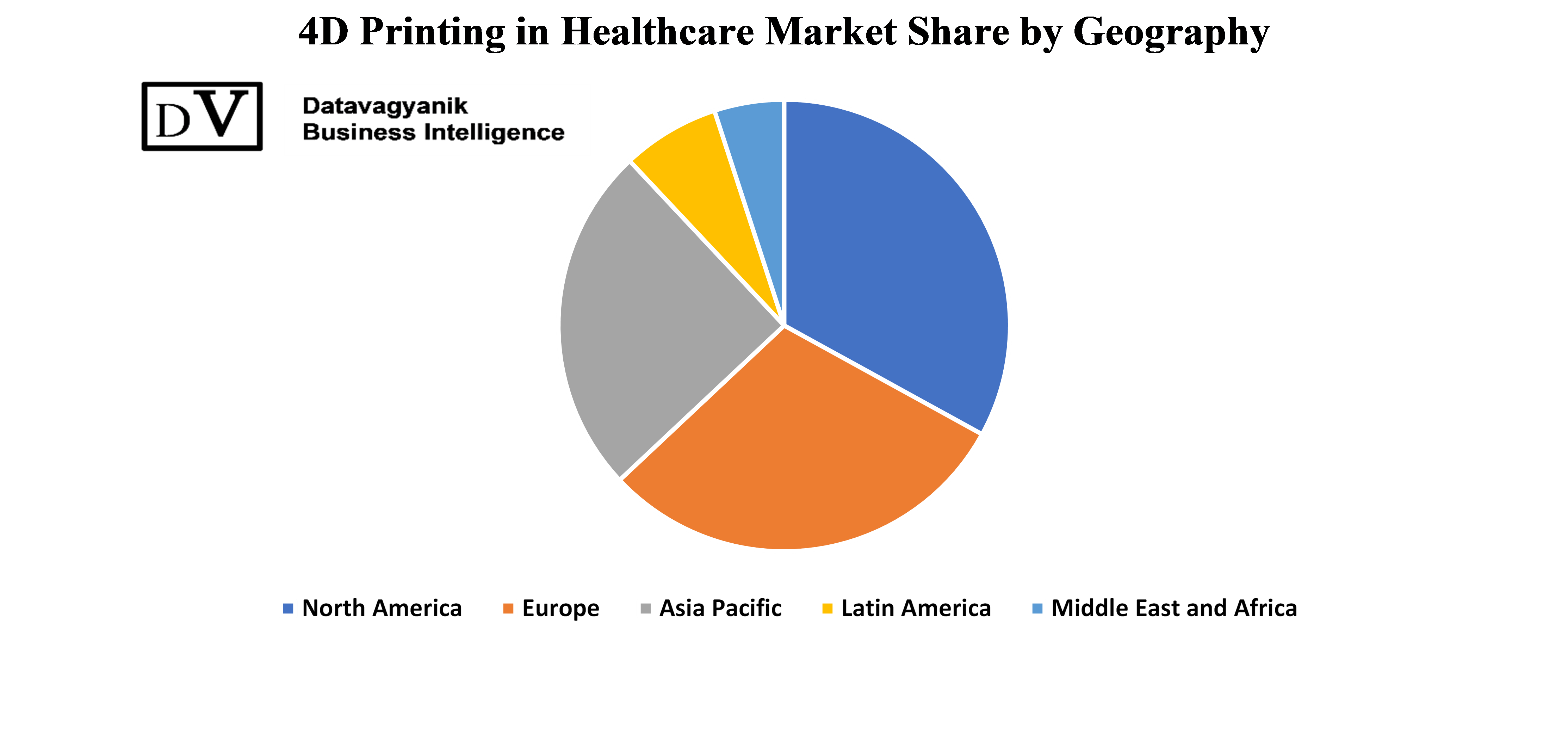© 2021 All rights reserved
Datavagyanik- Your Research Partner

The global 4D Printing in Healthcare Market size in 2022 is $ 18 billion and is expected to grow at 26 % CAGR during the forecast period. The global 4D Printing in Healthcare market is segmented into North America, Europe, APAC & Rest of the world. 4D printing is a new technology that allows us to create a 3-dimensional object by using 4 dimensions (x, y, z, and time). What do we mean by that? As opposed to creating objects layer by layer as in traditional 3D printing (also known as additive manufacturing), 4D printing actually allows us to control and manipulate material properties over time. This is accomplished by inserting sensors into soft materials that allow physical change to occur upon an external stimulus.
Scientific literature designates 4D printing as an advanced form of 3D printing, offering changing functions, properties, and shapes with time. It has been introduced as a separate field in medical science during the last few years. The goal of 4D printing in healthcare is to print medical devices and formulations tailored individually, paving the way to precision medicine.

4D printing by SLS technology uses a light-directed energy process to solidify a powder using layer-by-layer resolution with stereolithography systems. This allows you to create a prototype in four dimensions (x, y, z and time) which makes it much easier to test and study how your finished product will react under specific conditions

.
It is a rapidly emerging field that is replacing the conventional methods of manufacturing medical devices in industries. As discussed, 4D printing constructs the devices in a much similar way as that of 3D printing technology. However, machines of the former can mold with time, basically the 4th dimension. In addition, once exposed to a certain amount of light, water, and temperature, these devices can change their orientation, offering greater functionality.
The research report titled “4D Printing in Healthcare Market, Business and Opportunity Analysis” published by Datavagyanik presents a detailed analysis of the 4D Printing in Healthcare Market with country-wise market statistics, qualitative insights, and market player analysis. One of the prime objectives of the report is to provide an assessment of the market potential, market revenue, growth and business opportunities for 4D Printing in Healthcare Market in each country.
Why The Technology is So Revolutionary : While 3D printing may be more commonly associated with artistic creation or household manufacturing, there is a new area of health care where it can revolutionize how patients are treated—ultrasound and CT scans. Many medical professionals have taken to calling 4D Printing the next big thing because of its ability to do so much good for so many people.
Because 4D Printing does not work in a vacuum, we must also discuss how it differs from traditional 3D printing. First of all, there are two key characteristics to 4D Printing—invisibility and malleability. That sounds like an oxymoron, doesn’t it? How can something be invisible yet still be malleable? In order to understand that concept, you need to understand that 4D printing doesn’t create things with ink as a 2-dimensional printer would. Instead, it creates an object using heat and light waves in a liquid-based solution which finally solidifies into a material form. 4d printing has been used in cosmetic surgery to improve upon traditional 3d printing methods and processes for skin grafts and prosthetic limbs for several years now.
Addressing medical and surgical challenges with 4D printing: Four-dimensional (4D) printing promises to revolutionize bioprinting by enabling rapid prototyping of 3D tissues. Such technology could transform medicine by allowing doctors to virtually plan surgery before cutting into a patient’s body—the ultimate in personalized medicine. 4D bioprinting has already begun saving lives in veterinary medicine.
Meanwhile, 3D bioprinting is beginning to impact medical practice. Scientists are using cells extracted from patients to grow replacement body parts like skin and cartilage—parts that surgeons can use in transplant surgeries. However, these doctors still have to rely on 2D images of their patients’ bodies when deciding where exactly to implant new tissue. This limits how well surgeons can plan operations and risks introducing harmful mistakes into a patient’s treatment plan. 4D printing technology would allow surgeons to examine an MRI or CT scan and print body parts directly onto patients, allowing for much more precise surgery than is currently possible.
4D printing has provided an alternative route for the progression of the health care field. Some of the present and future advances of 4D printing in healthcare are the following.
Presently, technicians and doctors are working on constructing a functional heart model using the 4D printing technology. However, experts are still working to achieve a model whose density and rigidity correspond to that of the human heart.
Moreover, 4D printing has also helped assess blood movement through the heart using different color coding depending upon the velocities of the blood. Through this technique, doctors can look for abnormalities within the heart and plan appropriate interventions.
Bioprinting is the most better-understood phenomenon related to 4D technology. It helps in constructing grafts for human hard tissues such as bones. For example, after synthesizing a polymeric bone graft, experts implant human-derived bone stem cells in the graft to achieve bone mineralization. It has been observed that these grafts show maturation after their implantation in the human body. There are possibilities of fabricating more human tissues using 4D printing in the future.
Using magneto-restrictive materials and 4D printing allows the experts to devise innovative drug delivery services; these services aid in targeting drugs on a personalized basis along with appropriate dosing.
With increasing investments in 4D printing, there is a considerable chance that it will provide services that fulfill the innovative requirements in the future. Optimistically, 4D printing has the potential to become an essential technology for fabricating person-specific and customized implantable devices. These devices will be able to provide better output and improve the surgical outlook.
Moreover, the scope of 4D printing is not limited only to fabricating objects. But it can also be utilized for getting information about blood clots, infections, and breathing abnormalities. 4D printing is expanding at a rapid rate, and experts are looking forward to many future interventions in healthcare using 4D printing.
North America 4D Printing in Healthcare market size is expected to be – million and is expected to grow at a CAGR of –% till 2030. US & Canada will drive most of the revenue in the region. North America has a huge chunk of the global market.
Europe 4D Printing in Healthcare Market Size is expected to be—million and is expected to grow at a CAGR of –%. Germany, France & Italy are the most lucrative market for 4D Printing in Healthcare Market.
APAC 4D Printing in Healthcare Market Size is estimated to be $xx million in 2022 and is expected to grow at a CAGR of xx% during the forecast period.
The report analyzes 4D Printing in Healthcare Market from the demand as well as the supply side. In supply-side analysis, we reach out to the 4D Printing in Healthcare Market players to collect information on their portfolio, revenue, target customers, and other insights. During this process, paid interviews and surveys are conducted for obtaining and validating the data pointers. We also deep dive into the available paid industry databases, research studies, white papers, and annual reports.
As a part of our demand-side analysis, we reach out to the end-users of 4D Printing in the Healthcare Market, to gauge the application areas, demand trends, and similar insights.
The world is changing with time. Every field is trying to adopt something that offers better technology and services. As evident from the previous discussion, 4D printing is one of the latest technologies changing medical science’s outlook.
According to the report, 4D printing in the healthcare market size is $18 billion in 2022. However, driven by the investments from the government and various firms, this market is expanding at an impressive CAGR of 26% and is expected to reach almost $36 million by 2028.
Several end-users of 4D printing, including research institutes, hospitals, and clinics, dominate the market. However, specific barriers must be addressed to excel in the field at its full potential. One barrier includes strict regulatory policies for implementing 4D printing in healthcare.
In comparison, the increasing adoption of 4D printing in biotechnology and biomedical fields is one of the main factors accelerating this market’s growth. Moreover, other expediting factors include increased incidence of chronic illnesses, increased geriatric population, and mounting demand for the latest technology in healthcare.
This business analysis report on 4D Printing in Healthcare Market presents a regional as well as country-level analysis. The regions covered in the report are – North America, Europe, Asia Pacific, and the Rest of the World. In these four regions, all the countries have been covered in detail with information on 4D Printing in Healthcare Market size, trends, and forecast.

The report covers 4D Printing in Healthcare Market revenue and forecast for the period (till 2030), by regions, (further split into countries):
| Year | 2022 | 2024 | 2026 | 2028 | CAGR (2022-2030) |
| 4D Printing in Healthcare Market Revenue ($Million) | XX | XX | XX | XX | XX |
| Total | XX | XX | XX | XX | XX |
*Note – Country-level break-down has been covered in the report
“Every Organization is different and so are their requirements”- Datavagyanik







© 2021 All rights reserved
Datavagyanik- Your Research Partner
Add the power of Impeccable research, become a DV client